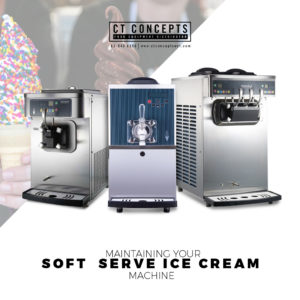Maintaining your Soft Served Ice cream Machine
Sanitizing 101
Ice cream and yogurt products produce a remnant bacterial byproduct that has the uncanny ability of finding its way into the back of units as a result of bad or worn seals. This quickly leads to an unforgiving odor and, without regular maintenance of the equipment, this sludge will gum up mechanical parts or drip on controls and relays, ultimately leading to the unit breaking down and a loss of revenue. Avoid this issue by properly sanitizing the machine regularly.
Health codes mandate sanitizing soft-serve machines to avoid product contamination. Some states require you to test for bacteria throughout the month. Sanitizing these machines usually involves an extra rinsing step with a manufacturer-approved sanitizing agent. Check local health codes for requirements.
Heat-treatment systems on some models can aid in sanitation. A heat-treatment system is the cycling of a daily heating-and-cooling process to safely control bacterial growth. Food-safety standards require a heat-treatment cycle every 24 hours. One company’s heat-treatment option can reduce the frequency of a full-machine disassembly and cleaning to 14-day intervals (28 days in some states). While this can be a great time saver, it doesn’t replace the need to properly wipe down the machine every day. It would also be a smart move to have a checks-and-balance system in place in case the heattreatment system hits a glitch.
Step By Step soft-serve machine
You’ll find there are general procedures for cleaning most soft-serve machines, but refer to your owner’s manual for specifics on your model.
To start, wash your hands thoroughly. Turn the machine off and wait for existing product to soften. Engage the draw valves and drain product into a clean bucket. (If the product is still fresh, you may be able to put it back in; check local health codes for requirements. If in doubt, throw it out.) When the machine is empty, pour cool water into the hoppers and rinse thoroughly. Drain the water and wipe out all residue from the hoppers.
Take note: many models have a separate wash mode that allows the scrapers to turn without running the freezing cycle; this mode prevents the wash water from freezing in the barrels.
When in wash mode, make sure to stop the machine between steps (such as between rinsing the machine with water, then following up with sanitizer) to avoid running the scrapers without any kind of liquid lubrication. If your machine doesn’t have a wash mode, refer to your operator’s manual for proper cleaning procedures.
To sanitize the machine, as mentioned, use a manufacturer-approved sanitizing agent to eliminate bacteria that can cause illness. Pour the sanitizer into the hoppers then run the machine in wash mode another five to 10 minutes. Drain the sanitizer from the machine. Once emptied, flush the sanitizer out of the machine with water. Repeat the flushing two to three times.
Disassemble, wash and sanitize small parts that can still hold bacteria such as the star caps and cylinders. Use brushes to get into the nooks and crannies. Let them soak about 10 minutes. Rinse with cool water and allow to air dry.
Clean or replace the condenser filter—a clogged filter makes the refrigeration system overwork to maintain temperatures because the unit can’t disperse hot air.
Reassembling, Restocking
Before reassembling a soft-serve machine, take a few minutes to lubricate certain parts. Usually these include any moving parts that are inside the machine as well as the handles and pins that keep them in place. The owner’s manual will inform you of the proper lubricant and where to apply it. Make certain to use a food-grade, sanitary lubricant. This is a key step in ensuring that parts move and seal properly.
Replace and restock any worn, damaged parts; stock any parts the manufacturer recommends. They may include O-rings, belts, filters, inserts, gaskets, scraper blades, brushes, and more. Don’t forget to keep sanitizing solution in stock. Most manufacturers have an auto-restock process for items that are bound to wear out from normal operation. Keeping a tune-up kit on hand means you can keep the machine working; otherwise you lose soft-serve sales while you wait for parts to arrive.
Mistakes To Avoid
Service technicians tell us they encounter the same “issues” time and again when it comes to soft-serve machine repairs. Most are easy to avoid. The following are a few to be aware of:
• Using petroleum jelly instead of the proper food-grade lubricant. Petroleum jelly can breakdown and contaminate product or damage the machine. Other oils gum up and get sticky. Only use the manufacturer-recommended lubricant and keep a supply on hand so no one’s tempted to “make do” with the wrong product.
• Losing pieces, such as gaskets or O-rings, when reassembling the unit. Train your employees to collect all the parts either in the parts mold supplied by the maker or in a plastic tub of some kind.
• Not going through the step to prime the product. This causes freeze-ups in the barrels and prevents the soft-serve from flowing.
• Not giving the unit enough room to ventilate. If the machine cannot disperse its hot air, the compressor has to work harder to maintain temps and it will wear out earlier.
• Installing the unit next to hot equipment, for the same reason above.
If your operation relies on soft-serve profits, it will serve you well to have a good working knowledge of its maintenance requirements. The more you know about the machine and how to care for it, the better it will consistently turn out tasty treats for customers. That experience will bring them back time and time again.
How to Clean and Operate Pasmo Ice Cream Machine https://www.youtube.com/watch?v=85n5Lv5VES0
Source :https://www.fermag.com/articles/7486-how-to-care-for-soft-serve-machines
#KitchenEquipmentPhilippines #FoodEquipmentPhilippines #SoftServeIceCreamMachine #IceCreamMachinePhilippines


